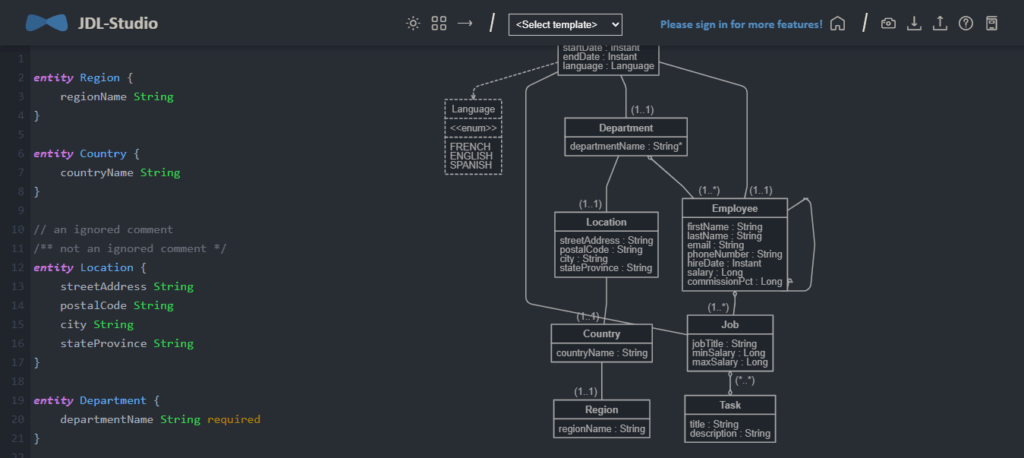
JHipster: The Fastest Way to Build Modern Web Apps

In the fast-paced world of software development, there’s constant pressure to move quickly without compromising quality. Companies want to validate ideas fast, iterate faster, and bring robust applications to production with confidence. Whether it’s a prototype, an internal tool, or a full-scale enterprise solution, engineering teams — especially those in IT outsourcing environments — are searching for ways to reduce boilerplate work and focus on what truly matters: solving business problems.
This is where JHipster comes in. Far more than a simple code generator, JHipster is a comprehensive development platform that empowers teams to model, generate, and deploy full-stack applications using proven, modern technologies. Its goal is simple yet ambitious: to accelerate development while maintaining a structured, scalable architecture.
What Is JHipster?
JHipster (short for Java Hipster) is an open-source development platform that allows developers to rapidly build web applications and microservices. It brings together best-in-class technologies into a ready-to-use project setup that includes both the frontend and backend. On the backend, it leverages the power and maturity of Spring Boot. On the frontend, it offers flexibility with Angular, React, or Vue.js. JHipster also integrates DevOps and cloud-native tools out of the box, making it a powerful choice for modern software projects.

It doesn’t just generate a skeleton — it generates a complete, functional, and production-ready application that includes core features such as user authentication, database integration, entity management, and a responsive UI. For teams facing tight deadlines, distributed setups, or resource constraints — such as outsourced software development teams — that makes all the difference.
The Benefits of Using JHipster
At its core, JHipster is about acceleration — not by cutting corners, but by automating the repetitive setup and configuration work that every project requires. Here are some of the most impactful benefits it provides:
1. Full-Stack Generation with Proven Technologies
JHipster creates a complete project structure using widely-adopted tools. You can generate:
- A robust backend with Spring Boot, built to scale
- A modern, responsive frontend using Angular, React, or Vue.js
- Pre-configured user authentication and authorization
- RESTful APIs, entity relationships, and database mappings
All of this is done with just a few commands. Developers can go from an idea to a working app skeleton in minutes — particularly valuable for outsourcing providers who aim to deliver MVPs and proofs of concept quickly.
2. Flexible Architecture: Monoliths or Microservices
JHipster supports both monolithic applications and microservice-based architectures. This flexibility is critical, especially for teams that start small and plan to scale later. The microservice blueprint comes with service discovery, API gateways, centralized configuration, and more, making it suitable for complex, distributed systems.
It also supports the reactive programming paradigm through Spring WebFlux, allowing teams to build responsive and scalable services tailored for modern workloads.
3. Tooling and Build System Integration
Out of the box, JHipster integrates build tools like Maven and Gradle, along with frontend build systems such as Webpack. It includes support for testing, internationalization (i18n), and code linting, all configured to work seamlessly together. This integrated setup helps reduce friction during development and deployment.
CI/CD pipelines can also be scaffolded, helping teams — including those working across different geographies or outsourcing hubs — standardize deployment practices early on.
4. Cloud-Native Readiness
For teams building cloud-native applications, JHipster provides support for Docker, Kubernetes, and OpenShift. It includes blueprints to generate containerized apps and YAML configurations for deployment. Infrastructure as Code (IaC) practices are baked in, making it easier to deploy and manage environments consistently across teams.
You can deploy apps to major cloud platforms using the generated scripts and configurations, reducing the complexity of environment provisioning — an essential feature for outsourcing partners managing multiple environments for different clients.
5. Developer Productivity
Ultimately, JHipster enhances productivity. By automating repetitive tasks and providing well-structured project scaffolding, it frees developers to focus on delivering features rather than debugging misconfigured build files or setting up boilerplate authentication.
Development becomes faster, more consistent, and less error-prone, which is especially valuable in agile environments where iteration speed is key. For IT outsourcing companies, this translates into faster delivery times and higher client satisfaction.
JDL: Modeling Your Domain with Ease
One of JHipster’s standout features is the JHipster Domain Language (JDL). It allows developers to define the entities, relationships, and constraints of their application in a simple, declarative syntax. Here’s a quick example:
entity Product {
name String required,
price BigDecimal required
}
entity Category {
name String required
}
relationship OneToMany {
Category{products} to Product{category}
}
With a single command, JHipster generates all the necessary backend and frontend code for the defined model: entity classes, database migrations, API controllers, and UI components. This is a massive time-saver, especially in the early stages of application development. It also ensures consistency across the codebase, reduces human error, and allows teams to iterate on the domain model with minimal overhead. As the project evolves, developers can easily update the JDL and regenerate code without losing custom logic, making it both a rapid prototyping and long-term maintenance tool.
Visual tools like JDL Studio make it even easier to experiment and share models with your team.

You can also version your JDL files and include them in your repository to keep the domain model in sync with your application evolution.
Real-World Use Cases
JHipster isn’t just for side projects or demos — it’s used in production by startups, enterprises, and government agencies worldwide. Here are a few typical scenarios where JHipster delivers value:
- Greenfield Projects: When speed is essential, JHipster provides a production-ready setup with authentication, database integration, and UI components out of the box.
- Microservice Architectures: JHipster simplifies the complexity of distributed systems by providing service templates, gateway configurations, and consistent patterns.
- Internal Tools and Dashboards: For building internal apps that don’t require extensive UI/UX design, JHipster’s ready-made frontends accelerate delivery.
- Educational and Onboarding Tools: Because it covers both frontend and backend, it’s great for helping junior developers understand how modern apps are structured.
Some teams even use JHipster for proof-of-concept projects to validate ideas quickly before committing to long-term development.
Considerations Before Adopting JHipster
Like any tool, JHipster isn’t without its trade-offs. Here are a few things to keep in mind:
- Learning Curve: While the generated code is clean and consistent, new developers must understand how Spring Boot, Angular/React, and JPA all fit together.
- Generated Code Management: Making manual changes to generated files can complicate upgrades. It’s important to follow best practices and keep custom logic separate when possible.
- Customization: Although JHipster offers a lot out of the box, highly customized UI or architecture may require significant tweaking.
JHipster is ideal for teams who understand the value of convention over configuration and want to work within well-defined architectural patterns.
Final Thoughts
 As the development landscape evolves, so does JHipster. The community continues to enhance its capabilities, supporting emerging tools and frameworks while maintaining stability for enterprise needs.
As the development landscape evolves, so does JHipster. The community continues to enhance its capabilities, supporting emerging tools and frameworks while maintaining stability for enterprise needs.
New blueprints, better CI/CD integrations, and cloud-first features make it a valuable ally for modern teams
If you’re exploring new ways to streamline development and scale faster, JHipster is worth a serious look. Whether you’re launching a greenfield project or modernizing an existing system, it offers tools and patterns that support scalability from day one.
This blog post was written by our software engineer – Nataša Rajtarov.



